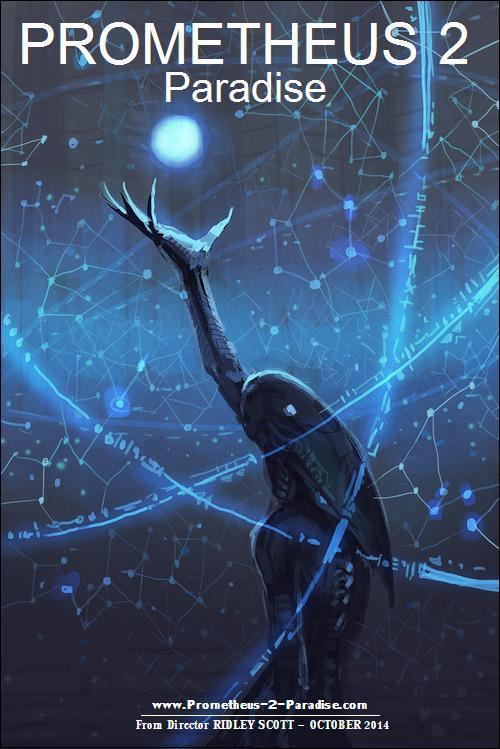the passing of time
Prometheus Forum Topic

pulserifle187
MemberOvomorphJan 2, 20133476 Views59 RepliesWhen captain janex sets up the christmas tree , he said to vickers that it was christmas day and that holidays were " made to mark the passing of time" ( i feel that there maybe something within this statement). At the end of the movie shaw narrative said that "its new years day 2094, the year of our lord" a week later.
It seems that 7 days have passed, but going what happend in the movie it only seemed that 3 days have passed, the events happend rather quickly. Does anyone else see any significance in this? Is this too much of a 'stretch'?
"how do you feel?"-" great, next stupid question"
Replies to the passing of time
Hey Guest, want to add your say?

zzpluralJanuary 04, 2013
@cupo
It is fun thinking about this kind of stuff, even if it is heady!
@BLANDCorporatio
[i]Would it help if, say, travel was taking some kind of shortcut? What if in my room there's a magical portal where a patch of land/spacetime from LV-223 is "glued" to my local space time, and I can just walk there in a second? Even though light, when not passing through the portal, needs 34 years to get there as measured by an Earth observer?[/i]
A bit like Stargate? Yes, fun and nonsense for a movie, but actually quite impossible, since [url=http://www.theculture.org/rich/sharpblue/archives/000089.html]causality is violated[/url]. It's possible to receive a response to a signal before the signal is sent.
I'm happy to accept that the basic premise of travel in Prometheus is fantasy. Although, I'd be quite a bit happier if they just relied on the tried and trusted principles of time dilation to account for the 2-year journey time.
@SnorkelBottom
[i]If photons travel in Zero time, then one could argue they also travel in Zero Space, yet if that was the case the photon would be stationary. Yet as Einstein clearly stated space and time are relative, if light travels through space it also travels through time or more precisely, because they are relative to one another - space-time, at the rate of 186,000 miles per second.[/i]
Actually, I understand that physicists typically refer to the photon's travel time as [i]null[/i] time rather than zero. It's not even nothing, and you can't do regular maths with it, like divide distances and times to get speeds. One description I read that I quite liked was that when a photon goes from point A to point B, it's as if the two end points of the journey are stapled together in space (well, it is relativistic after all, and a photon's point of view is quite different to ours). In other words it's at the beginning and end of its journey at the same time and the same place. Under these circumstances, it starts to get a bit metaphysical and you wonder if in real terms the photon ever exists at all.
The most terrifying fact about the universe is not that it is hostile but that it is indifferent
javablueJanuary 04, 2013
[i]A Ship travels, from Earth, for a period (experienced by the crew) of 10 years, a distance of 10 light years, at the speed of light, at the end of this mission they are back at earth (a round trip), yet 1000 years has passed on Earth instead of the 10 the crew experienced.
The accompanying question was, at what speed is the ship travelling, the speed of light as experienced by the crew or 1/100th the speed of light as experience by spectators on Earth.[/i]
Sorry Snorkelbum but I think your wrong unless I'm not following your wording of the situation. If the crew travel 10 light years at SoL then they will experience a much shorter ship time than 10 years (in fact, travelling at SoL the crew wouldn't experience any time passing, would it?). The 10 years ship time and the 10 light years contradict each other. Sounds like you've described the view of the mission from earth's perspective.
Also all observers will see light travel at SoL - so the earthling will see the spaceship traveling at the speed of light. Not sure where the 1/100 comes into it. Perhaps at the SoL the crew don't age and those on earth age 1000 years but I cant be bothered working that out - even if I could.
I think you need to drop the crew experiencing 10 years from your example. That's more likely what earth will experience.
ps the log in process on this site is a real pain in the arse.
javablueJanuary 04, 2013
Time in Prometheus seems to be important - we get a lot of info on it - much of it seemingly contradictory. In Alien and BR there is no issue made of time so we just accept they have a way of traveling great distance without having to worry too much about time.
javablueJanuary 04, 2013
Janek's statement about the holidays "marking the passing of time" is him saying that they traveled at the SoL at which time stands still so by marking the hols he is creating the impression time has passed. That contracts the 2.5 years from other info and the info from David (which also contradicts the 2.5 years).
Then there's David's 36 hours which may mean they traveled from a planet that takes more than 36 hours to rotate on its axis.
And then there's Vicker's half a billion miles from earth.
But I suppose they're all fuck ups by Ridley.
Indy JohnJanuary 04, 2013
"..Susskind to do it, I recommend his lectures at Stanford..."
I checked out tghe man' video lecture and found it worthwhile. Susskind clearly has a great understanding of Physics but his also smart enough to 'dumb it down' so that regular folks like me can grasp at the basics.
Perhaps after few lessons i could begin get hints of Susskind thinking on the more complex issues.
I can't comment on the time question but have enjoyed reading all the posts. A lively debate and prodding that I hope are not personal attacts but careful pokes to move toward a better understanding of our movie.
Be choicelessly aware as you move through life

Cerulean BlueJanuary 04, 2013
I think Sir Ridley needs to hurry up with the new movie release, so we can get back to talking about Engineers ripping off people's heads!

caenorhabhditisJanuary 04, 2013
itd be good if they did what nolan did with the last two batman films and "accidentally" leak a prologue scene to give us something to tide us over!....
I LIKE WORMS! I LOVE WORMS!

Indy JohnJanuary 10, 2013
".. ripping off people's heads.."
Hmm. Yes becausae without new material it has got me thinking.
If Shaw could by remote control have access to the robot's physical attribute that might be enough to make her think she has some control of the future.
I would like to see and hear how David and Shaw work out the re-connection steps for a united David.
I don't think that Shaw could take over/learn enough of the Engineer's technical skills to do without David's brain. But I do wonder just what advanced skills she can add to her persona, her brain power and her command of the Juggernaut while on tghis journey. we saw started at the end of our movie.
Heck you might think there would be an archive of Engineer recordings to better understand what has happenned in LV-223
Be choicelessly aware as you move through life

caenorhabhditisJanuary 10, 2013
this is the thing we have a rough idea that the next film will see shaw and david go "where they came from" and that shaw has already left lv223 in a juggernaut or at least thats how it appears!
we also know and ridley scott backed up the idea that if david gets his head back on he'll be a threat but that doesnt mean shaw wont do it! in fact i imagine that most would be interested to see how that pans out (correct me if i'm wrong) i also wonder if thetll go straight there or wether thay will be waylaid or forced to detour because it just seems odd scene wise that they should suddenly turn up at paradise are there to be no other humans in the cast? who knows the writers have a heck of a job ahead of them!
I LIKE WORMS! I LOVE WORMS!
Indy JohnJanuary 10, 2013
"..are there to be no other humans in the cast.."
Fox could not let this happen.
But somehow there needs to tie in with other humans, not yest known, to explore the storyline in Paradise.
Shaw is at David's mercy as to where he pilots the Juggernaut.
He may even suggest ancd sell Shaw that it would be better to go to an outWorld to trade this ship for real Earth Ship and continue to complete the Corporate goals and now it seems Shaw's goals.
However the more that Shaw is distracted from immediatly going to 'Paradise' the longer time it will be to answer her questions.
Wouldn't that be strange if what we call Earth is really the Engineer's Paradise/homeworld.
Be choicelessly aware as you move through life

caenorhabhditisJanuary 10, 2013
"Wouldn't that be strange if what we call Earth is really the Engineer's Paradise/homeworld."
yes! haha! would explain why they hate us too spesh if they got shunted out by the "ones who made them" maybe theyre like our older siblings and the true parent species said to the engineers 'right hop it! you need to go find your own planet n get a job n a haircut' and the engineers resent us for it lol
plus the fact that the weyland corp website details all the planets and their industry might be because david will cause a detour to get himself fixed up! maybe we will acquire more characters that way?
I LIKE WORMS! I LOVE WORMS!
Indy JohnJanuary 10, 2013
I like your thinking caenorhabhditis.
In this re-fitting of David there is time to gather a few more charactors and then continue the Paradise storyline.
What ship would they use?
The Juggernaut would most acceptable/recognizable to other Engineers.
Be choicelessly aware as you move through life

caenorhabhditisJanuary 10, 2013
thats true and it has the co-ordinates etc safer to travel in a ship thats proven its ability to make the journey i mean even if you had the right maps itd make more sense to cross the atlantic in a well trans-atlantic liner than a tugboat lol plus if they show up in a human and in engineer perspective alien craft they would be more likely to be shot out of the sky although the planets inhabitants might not be happy to see a warship with two strangers at the helm pull into orbit either!
I LIKE WORMS! I LOVE WORMS!
Indy JohnJanuary 10, 2013
In fact why only send one ship? Send several or an armada!
Paradise could be the action film that many expected based on the Prometheus trailers.
The P3 could then be the serious.thoughtful. serious movie that many site members prefer..as the storyline leads up to Alien.
Be choicelessly aware as you move through life

caenorhabhditisJanuary 10, 2013
hmmmn an armada wouldnt advise it would you? haha
p.s cant read my mail so if its something i can answer now?...
I LIKE WORMS! I LOVE WORMS!
Indy JohnJanuary 15, 2013
"..It seems that 7 days have passed, but going what happend in the movie it only seemed that 3 days have passed, the events happend rather quickly.."
Getting back to the original question it did seem like there were only 3 days in the storyline up to the Shaw rescue of David.
Then all is lost until the final report that Shaw gives on Prometheus.
As filled with activities our movie presentend there seems to be a lot of time before the Juggernaurt lift off.
That lost time (off screen)could be quite productive especially if head/torso were joined together.
Asssuming that David could decipher the basics of the Juggeranut operation he would have unlimited access to any stored knowledge this alien ship offerred.
Think of the cumpuer speeds and accessablitly to the equivelent of the 'net. Heck David's head might explode if it was crammed with everything Engineer related.
The real question is what would Shaw be doing in this 4 day pre launch time. Although smart she wpould be at a disadvantege in understanding the Juggernaut.
I was in her position I might explore the rest of the Pyramid and even the surrounding domes with a bit of David's suppervision.
I think that David would want Shaw around for the next world so he would keep her looking at 'safe' areas.
The one question was when the Deacon is seen in the timeline.
It would be hard to believe that the Deacon, if it was soon born after Shaw leaves the shuttle, and it's intense survivial instincts would not seek out any being to continue it's life.
If Deacon goes to other Domes and finds Engineers then that will keep it busy and away frrom David/Shaw.
If the Deacon turns it's attention to our two crew memebers then any kind of storyline is possible...including athrowdown with the new born threat.
That could be a deadly case of hide and seek.
We can assume that Shaw won.
Be choicelessly aware as you move through life
ThatSMJanuary 21, 2013
I'd put the main part of the film occurring over 2 days rather than 3 - wake on Christmas morning, land in the afternoon, night, all sorts of bad things happen the next day (with very little time in between for much time to pass beyond the obvious). Musta took Shaw and David the rest of the time to work out how to fly the ship. We only see one night in the film, and can only guess that the planet has a rotation similar to Earth (albeit retrograde).
Good thing Deacons have long gestations...
Indy JohnJanuary 22, 2013
"..Good thing Deacons have long gestations..."
Just about the longest alien gestation time depicted in our movie.
Infact if this time was any shorter and found David/Shaw on the moon this would make for one heck of a throwdown for all of the known surviviors and the Deacon.
Somehow our crew members defeat the last born alien and leads into the Shaw's last message about Prometheus and the moon.
Now that would be a great intro to going to Paradise.
Be choicelessly aware as you move through life
Are you an avid Alien fan looking for a dedicated online community of likeminded fans? Look no further! Create your own profile today and take part in our forums and gain XP points for all the content you post!









